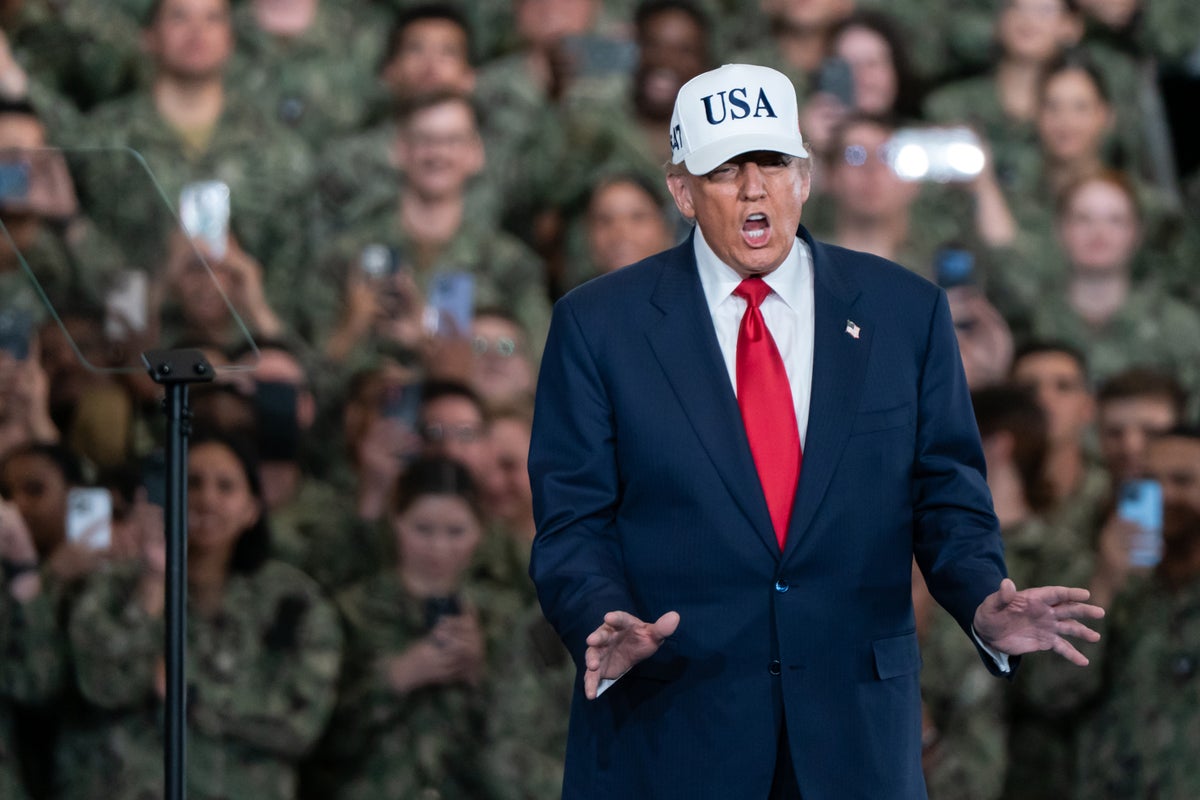
President Donald Trump rarely has anything negative to say about the men and women of the U.S. military, but he made an exception on Tuesday to offer a rare criticism of America’s fighting forces: They may be too “good-looking” for his tastes.
Trump was in the midst of an address to sailors aboard the U.S.S. George Washington, the Nimitz-class aircraft carrier that is semi-permanently based at the American naval base in Yokosuka, Japan, when he paused an attempt to praise the assembled service members to rant about their excessive attractiveness.
Speaking on the second day of a multi-day, multi-country trip through Asia that will conclude after a planned summit with Chinese leader Xi Jinping on Thursday, Trump said the Navy’s “ultimate strength” comes from “the men and women of the rank and file,” calling his uniformed audience “incredible people” and “good-looking people.”
After a beat, he said there were “too many good-looking people” present.
“I don’t like good-looking people,” he continued, as the sailors laughed at their commander-in-chief’s bizarre remark.
“I never liked good-looking people, I’ll be honest with you … never admitted that before,” he said.
The president’s meandering, stream-of-consciousness remarks followed a theatrical arrival to the George Washington, which is forward-deployed in Japan as part of the permanent American military presence that has remained there pursuant to 1960 joint defense treaty that replaced an earlier agreement imposed as a condition of end the post-World War II occupation of Japan by U.S. forces.
Trump, who made his entrance on one of the aircraft carrier’s massive elevators that are used to ferry planes and helicopters from hangars to the carrier’s enormous flight deck, eventually launched into a litany of complaints about the elevator and catapult systems aboard the newest class of American carriers starting with the class’ lead ship, U.S.S. Gerald R Ford.
Unlike the previous Nimitz-class carriers like the one on which the president was speaking, the Ford-class uses massive electromagnets to raise and lower elevators used for aircraft as well as those employed to move munitions from armored hangars up to the flight deck for loading on aircraft.
The Ford-class also uses an electromagnetic system to power the catapults used to launch aircraft from the flight deck and the arrestor gears which slow planes down as they land upon their return.
The new systems are favored by the Navy because they allow planes to be armed and launched at double the speed of the hydraulic elevators and steam-powered catapults aboard older carriers such as the George Washington. The electromagnetic catapult system, known as EMALS, also permits smaller aircraft such as drones to be launched from carriers and can launch advanced fighters such as the F-35C with far less wear and tear on the expensive planes’ fragile airframes
But Trump, who oversaw the commissioning of the Gerald Ford during his first term and complained about the newer systems back then, claimed the electromagnetic systems could easily be damaged by water — something systems aboard Navy ships are designed to withstand.
“You know, the new thing is magnets. So instead of using hydraulic that can be hit by lightning and it’s fine. You take a little glass of water, you drop it on magnets, I don’t know what’s going to happen,” Trump said.
“So, you know, the elevators come up in the new carriers—I think I’m going to change it, by the way—they have magnets. Every tractor has hydraulic, every excavator, every excavating machine of any kind has hydraulic. But somebody decided to use magnets.”
Continuing, Trump asked the assembled sailors aboard George Washington to opine on whether they prefer the older system or the new one before suggesting that he’d order the Navy to return to the steam-based catapults and hydraulic elevators on future carriers.
“I’m going to sign an executive order. When we build aircraft carriers, it’s steam for the catapults and its hydraulic for the elevators. We’ll never have a problem,” Trump said.
He referred again to prior difficulties during the Ford’s shakedown period and vowed to have the Navy reverse course a second time.
“They spent $993 million on the catapults trying to get them to work. And they had steam, which works so beautifully, and it has for 50 years,” Trump said. “I’m going to do an executive order. I’m not going to let them continue to do this.”
The White House did not immediately respond to a request for comment on whether Trump intends to follow through with his plan to use his executive authority to upend the construction of the Ford-class carriers by mandating a return to the older steam-based systems.
Such move would require massive revisions to the design of the cutting-edge supercarriers, of which ten are planned to replace the existing Nimitz-class ships that form the backbone of America’s carrier fleet.
Two such vessels, the future U.S.S. John F Kennedy and the future U.S.S. Enterprise, are currently under construction at the Huntington Ingalls Industries shipyard in Norfolk, Virginia.
Construction on two more, the future U.S.S. Doris Miller (named for the first Black recipient of the Navy Cross) and the future U.S.S. William J Clinton, is scheduled to begin in 2026 and 2027, respectively.
A planned start date for the sixth of the planned ten carriers, the future U.S.S. George W Bush, has not yet been set. That ship, which will be named for the 43rd President of the United States, will eventually serve alongside the tenth Nimitz-class carrier that was named for the 41st president, the U.S.S. George HW Bush.
